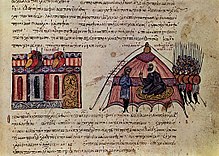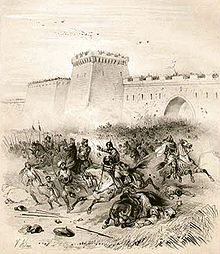Emirate of Bari

The Emirate of Bari was one of 847 existing to 871, from Muslim but non-Arab units but by Berbers conquered state system within the Apulian city of Bari . It was recognized as an emirate around 863.
Conquered on the initiative of the Aghlabids residing in Kairuan , who employed the Emir Kalfūn (Chalfūn or Khalfūn) (841 – around 852) in Bari, it made itself largely independent under the second Emir Mufarrag ibn Sallam (around 852 - around 857). Instead of in Kairuan, the headquarters of the Aghlabids, the emirs successfully sought recognition from Baghdad as Wālī , as governor. The Aghlabids had only made themselves independent from Baghdad's rule around 800. The second emir, who had achieved this recognition through Baghdad and also through its governor in Egypt, operated, like his successor Sawdan (Sawdān) (around 857-871), an independent expansion policy in southern Italy. Ludwig II , who was the only Carolingian to adopt an all-Italian perspective, temporarily subjugated Benevento and conquered Bari from the Saracens . Around 875 Bari came to Byzantium .
Conquest by the Aghlabids (841), independence, raids
Already about a year before the conquest in 841, Berber units attacked the city and briefly occupied it. Under the leadership of Kalfūn, possibly an escaped Aghlabid slave, the conquest succeeded in 841.
Under the three emirs there were raids to Capua (841), Naples (856), Conza (858 and 862) and Venafro (862); Ascoli and the Abbey of San Vincenzo al Volturno were looted in 861 and, like Montecassino, were forced to pay 3,000 gold coins ("tres milia aureos"). These raids led Ludwig II to move south and besieged Bari in 852, albeit in vain. Even in 860 he couldn't do much. Apparently the Muslim conquerors who had also ruled Taranto since about 840 and remained there until about 880 did not combine with those of Bari.
The third emir came to power by assassinating his predecessor. He attacked Duke Adelchis of Benevento , who had to pay him tribute. In 863, according to other authors in 864, it was formally recognized by Baghdad. According to the Itinerarium Bernardi , the report of Frankish monks who wanted to travel to the Holy Land as pilgrims, the obliging emir of the “civitas Saracenorum” issued them a letter of safe conduct . In their opinion, Bari belonged to the Duchy of Benevento before the Berber conquest. From the letters of safe conduct they promised themselves protection in Egypt, where they set off from Taranto .
According to the Jewish chronicle of Achimaats ben Paltiel , the chronicle of Oria from the 11th century, the emir was a wise ruler who maintained contacts with the Jewish scholar Abu Aaron. In contrast, Christian chronicles describe him as “nequissimus ac sceleratissimus” (nequam = useless, messy, frivolous; sceleratus = outrageous, criminal), i.e. as extremely frivolous and outrageous. These were still comparatively mild terms, as Barbara Kreutz (p. 39) noted. In 859 Lambert I von Spoleto, Count Gerard von Marsi, Gastalde Maielpotus von Telese and his colleague Wandelbert von Boiano tried to cut off the Emir after a campaign against Capua and the Terra di Lavoro of Bari, but this did not succeed despite a tough fight.
The city of Bari may have benefited from the occupation, as tributes, but above all income from the slave trade, benefited the local economy, but also from the trade in wine and pottery . After the Chronicon Salernitanum there were indeed diplomatic contacts with the Christian neighbors. Legati were sent to Salerno to stay at the episcopal court. At least in one case, Bari took in a refugee who found safety there from Emperor Ludwig II.
Conquest by Franks and Lombards under the leadership of Emperor Ludwig II (865–871)
In 865, possibly under pressure from the Pope, Ludwig asked the men of northern Italy to assemble in Lucera in the spring of 866 to attack Bari. It is unclear whether an attack took place at this time, but in the summer of that year the imperial couple - Ludwig and Engelberga traveled to the south - received the request from Adelchis, but also from Waifar von Salerno and Landulf II von Capua , to attack Bari again. In the spring of 867 his army besieged Matera and Oria , who had only recently fallen, and Matera was burned down - possibly because the city, unlike Oria, had resisted. Both Erchempert and Lupus Protospatharius report on the fighting. The conquests are likely to have at least made communication with Taranto, who is also Muslim, more difficult. Ludwig left a garrison in Canosa on the border between Benevento and Bari, but in March 868 he retired to Benevento. Around this time he entered into negotiations with the Eastern Roman Emperor Basil I. It is possible that a dynastic marriage was agreed between the eldest son of the Byzantine emperor and Ludwig's daughter, for which Byzantium promised naval support. In the Chronicon Salernitanum it remains unclear who initiated the initiative.
The joint attack was initially planned for the summer of 869. According to the Annales Bertiniani , 400 ships under the command of the Niketas Oryphas set out to sea. It is unclear whether the fleet arrived in southern Italy in the autumn or whether Ludwig refused to hand over his daughter immediately because the admiral behaved so badly. In any case, Ludwig complained in a letter about his defamatory behavior.
When the Berbers of Bari resumed their raids in 870 and even crossed Monte Gargano , where the Santuario di San Michele Arcangelo was located, Louis responded with a counter-campaign through Apulia and Calabria , but without attacking the urban centers of Bari and Taranto. Encouraged by his successes, he attacked Bari with the support of Franconian and Longobard units and a Slavic fleet. In February 871 the citadel fell into their hands and the emir was brought to Benevento in chains. The claim of the mid-10th century De Administrando Imperio , written by Emperor Constantine VII. That the Byzantine fleet played a decisive role in the conquest, is doubted in research.
swell
Latin sources, classification of the conflict
In historiography, the campaign of Ludwig II was interpreted as a religiously motivated, personal fight of the king against the Muslims, whereas the motive of the expansion of immediate imperial power received little attention. Against this expansion, if one follows the sources closer to the time, local rulers, as well as the Byzantines and the Pope, resisted. The aforementioned historians, especially those of the contemporary Erchempert , the Historia Langobardorum Beneventanorum , which continued the Longobard history of Paulus Deacon , complained much more about violence against property than against people. In addition to this important source, there are three scarce chronical works, the Cronicae Sancti Benedicti Casinensis . These four works were created in the Monte Cassino monastery . However, while the three short chronicles were written in the 860s, Erchempert only wrote in the 890s. In addition, there is the Gesta Episcoporum Neapolitanorum , the Liber Pontificalis , and finally a brief history of Carolingian undertakings from the pen of Andrea da Bergamo , which arose after 877. There are also certificates. It was only the Chronicon Salernitanum from the 10th century that exaggerated any form of Saracen violence and focused on the conflict between religions. The chronicles from the 9th century never mention rape, especially not on an altar, as the chronicle of the 10th century claims.
Jewish and Arabic sources
The work of the Jewish author Achimaats ben Paltiel , also Ahima az ben Paltiel, on the other hand, describes Emir Sawdan as a wise and powerful friend of his family. Statements about the attitudes of the 9th century cannot be drawn from these late works.
In addition to the Chronica Sancti Benedicti Casinensis , the Chronicon Salernitanum and Erchempert's work as well as the pilgrims' report by Bernard and the Jewish chronicle of the 11th century, i.e. the works from Christian or Jewish pens, it is above all Al-Balādhurīs "Book of Conquests" that the Represents events from a Muslim point of view. He died in Baghdad around 892. We have news from him that the conqueror of Bari was a mirwah , a former servant or perhaps a freed slave. The recognition of his two successors by Baghdad has also come down to him. His information found its way, partly literally, into the important historical work of Ibn al-Athīr .
Editions
- Chronica Sancti Benedicti Casinensis
- Chronicon Salernitanum , archive.org, January 5, 2011
- Erchempert : Historiola , archive.org, April 8, 2011
literature
- Barbara M. Kreutz: Before the Normans. Southern Italy in the Ninth and Tenth Centuries , University of Pennsylvania Press, 1996, pp. 36-54.
- Giosuè Musca: L'emirato di Bari, 847-871 , Edizioni Dedalo, Bari 1964.
- Sarah Whitten: Franks, Greeks, and Saracens: violence, empire, and religion in early medieval southern Italy , in: Early Medieval Europe 27 (2019) 251-278.
Remarks
- ↑ Alex Metcalfe: The Muslims of Medieval Italy , Edinburgh University Press, 2009, p. 21.
- ↑ Marco Di Branco, Kordula Wolf: Berbers and Arabs in the Maghreb and Europe, medieval era , in: Immanuel Ness (Ed.): The Encyclopedia of Global Human Migration , Vol. 2, Chichester 2013, pp. 695-702, here : P. 700 ( academia.edu ).
- ^ Marco Di Branco: Strategy di penetrazione islamica in Italia meridionale. Il caso dell'Emirato di Bari , in: Kordula Wolf , Klaus Herbers (Ed.): Southern Italy as Contact Area and Border Region during the Early Middle Ages. Religious-Cultural Heterogeneity and Competing Powers in Local, Transregional and Universal Dimensions , Cologne 2018, pp. 149–164.
- ^ Barbara M. Kreutz: Before the Normans. Southern Italy in the Ninth and Tenth Centuries , University of Pennsylvania Press, 1991, Paperback 1996, p. 25.
- ↑ The siege of Ragusa by the Aghlabids, which was only found in Constantine Porphyrogenitus and which supposedly lasted 15 months , which preceded that of Bari after him and which was broken off in the face of an Eastern Roman fleet, cannot be classified chronologically . Constantine places it in the 860s, but Bari was conquered more than two decades earlier. It is possible, however, that there are two sieges that the chronicler does not distinguish, because he names Sawdan, Kalfūn and Saba of Taranto as protagonists (Alex Metcalfe: The Muslims of Medieval Italy , Edinburgh University Press, 2009, p. 20).
- ^ Barbara M. Kreutz: Before the Normans. Southern Italy in the Ninth and Tenth Centuries , University of Pennsylvania Press, 1991, Paperback 1996, p. 37.
- ^ Barbara M. Kreutz: Before the Normans. Southern Italy in the Ninth and Tenth Centuries , University of Pennsylvania Press, 1991, Paperback 1996, p. 40.
- ↑ LA Berto (ed.): Cronicae Sancti Benedicti Casinensis , Florence 2006.
- ^ Sarah Whitten: Franks, Greeks, and Saracens: violence, empire, and religion in early medieval southern Italy , in: Early Medieval Europe 27 (2019) 251-278.
- ↑ Alex Metcalfe: The Muslims of Medieval Italy , Edinburgh University Press, 2009, p. 19.

